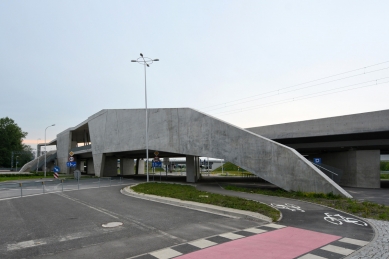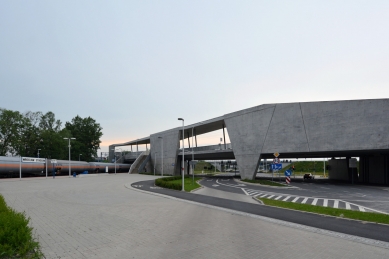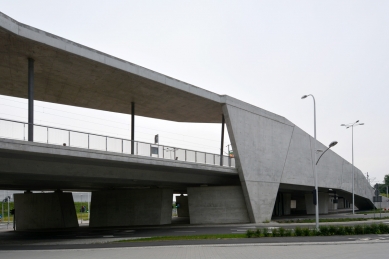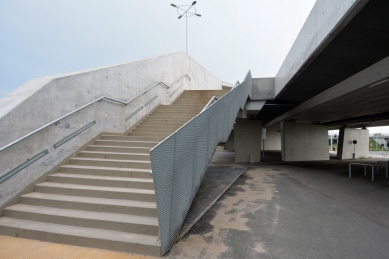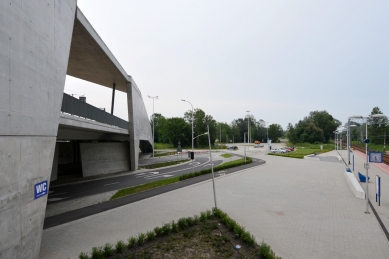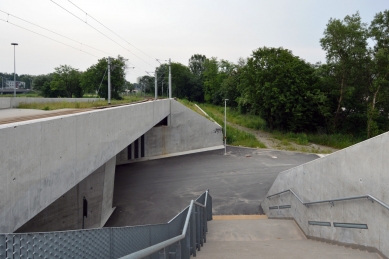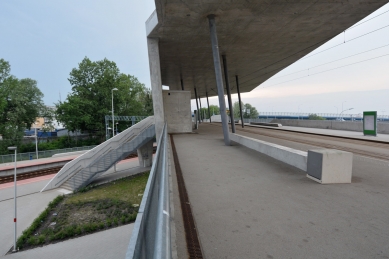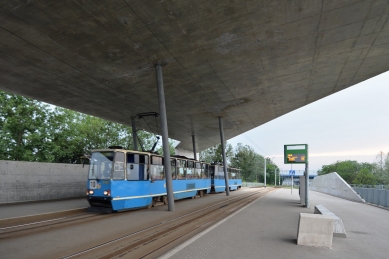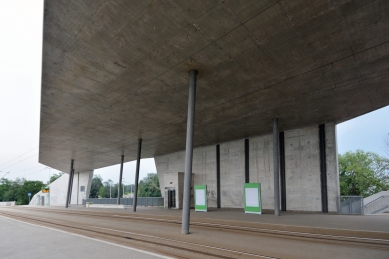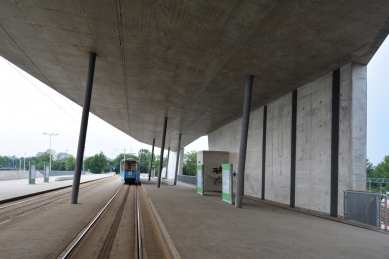
Train and tram stop
Integrated Transfer Node MPK-PKP Euro 2012

In connection with the 2012 World Cup in football, several new stadiums were built in Poland, as one of the two co-hosting countries. The construction significantly affected the transport infrastructure in the construction and reconstruction of roads and the improvement of public transport in the cities. At the new football stadium in Wrocław, the need for a new stop arose, which I would functionally and capacitarily cover for visitors disembarking here not only from the tram but also from the train. At the intersection of the railway and tram lines, a unique stop was created, combining the needs of both types of public transport. The unusual shape of the building was defined not only by the routes of the rail transport but also by the lines of the related roads, pedestrian and bicycle paths. The authors of the construction initially searched for the shape almost exclusively using models made of cardboard or plasticine. Together, the architects developed five conceptual variants before arriving at the final shape of the building.
The stop’s project was completed in 2008, and there were many times when it seemed that the construction would not be realized at all or would have to be significantly changed for financial reasons. That it was ultimately possible to realize the construction according to the original project also helped that the building received several architectural awards, including the highest accolade at the Biennale of Young Architects in Minsk, even while still being a project. The building was eventually completed in 2011 and handed over for use a year before the championship began.
The railway station is situated at ground level and above it, several meters high, is crossed by a tram line with a stop. The size of the upper platform is dictated by the number of people attending the sporting events. The concrete roof over the platform is supported by a pair of concrete walls and steel columns, which are placed on the side of the view of the stadium in such a way as to disturb the view of incoming visitors as little as possible. The asymmetrical shape of the roof arises from the need to guide people disembarking from the tram to the city stadium. The shape contrasts with the clear shape and graceful curves of the city stadium and thus very well reflects its function and location in the transport intersection.
Half a year before completion, the station was vandalized. A large amount of graffiti appeared on the large concrete walls. Although some documented "pictures" look very fresh in the photographs, they were ultimately removed, and the whole building was cleaned. To prevent further damage, the entire station is now monitored by a security camera system.
The stop was nominated for the Mies van der Rohe Award in 2013, along with other Polish buildings. In contrast to the modern and dynamic architecture of the stop, the passing trams of the Wrocław transport company appear somewhat archaic.
The stop’s project was completed in 2008, and there were many times when it seemed that the construction would not be realized at all or would have to be significantly changed for financial reasons. That it was ultimately possible to realize the construction according to the original project also helped that the building received several architectural awards, including the highest accolade at the Biennale of Young Architects in Minsk, even while still being a project. The building was eventually completed in 2011 and handed over for use a year before the championship began.
The railway station is situated at ground level and above it, several meters high, is crossed by a tram line with a stop. The size of the upper platform is dictated by the number of people attending the sporting events. The concrete roof over the platform is supported by a pair of concrete walls and steel columns, which are placed on the side of the view of the stadium in such a way as to disturb the view of incoming visitors as little as possible. The asymmetrical shape of the roof arises from the need to guide people disembarking from the tram to the city stadium. The shape contrasts with the clear shape and graceful curves of the city stadium and thus very well reflects its function and location in the transport intersection.
Half a year before completion, the station was vandalized. A large amount of graffiti appeared on the large concrete walls. Although some documented "pictures" look very fresh in the photographs, they were ultimately removed, and the whole building was cleaned. To prevent further damage, the entire station is now monitored by a security camera system.
The stop was nominated for the Mies van der Rohe Award in 2013, along with other Polish buildings. In contrast to the modern and dynamic architecture of the stop, the passing trams of the Wrocław transport company appear somewhat archaic.
Vladimír Balda
The English translation is powered by AI tool. Switch to Czech to view the original text source.
0 comments
add comment


